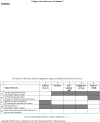Patient navigation: development of a protocol for describing what navigators do
- PMID: 20132342
- PMCID: PMC2838158
- DOI: 10.1111/j.1475-6773.2009.01079.x
Patient navigation: development of a protocol for describing what navigators do
Abstract
Objective: To develop a structured protocol for observing patient navigators at work, describing and characterizing specific activities related to their goals.
Data sources/setting: Fourteen extended observations of navigators at three programs within a national trial of patient navigation.
Study design: Preliminary observations were guided by a conceptual model derived from the literature and expert consensus, then coded to develop and refine observation categories. These findings were then used to develop the protocol.
Methods: Observation fieldnotes were coded, using both a priori codes and new codes based on emergent themes. Using these codes, the team refined the model and constructed an observation tool that enables consistent categorization of the observed range of navigator actions.
Findings: Navigator actions across a wide variety of settings can be categorized in a matrix with two dimensions. One dimension categorizes the individuals and organizational entities with whom the navigator interacts; the other characterizes the types of tasks carried out by the navigators in support of their patients.
Conclusions: Use of this protocol will enable researchers to systematically characterize and compare navigator activities within and across programs.
Similar articles
-
An assessment of patient navigator activities in breast cancer patient navigation programs using a nine-principle framework.Health Serv Res. 2014 Oct;49(5):1555-77. doi: 10.1111/1475-6773.12184. Epub 2014 May 13. Health Serv Res. 2014. PMID: 24820445 Free PMC article.
-
Patterns of task and network actions performed by navigators to facilitate cancer care.Health Care Manage Rev. 2014 Apr-Jun;39(2):90-101. doi: 10.1097/HMR.0b013e31828da41e. Health Care Manage Rev. 2014. PMID: 23478753
-
Cancer patient experience with navigation service in an urban hospital setting: a qualitative study.Eur J Cancer Care (Engl). 2016 Jan;25(1):132-40. doi: 10.1111/ecc.12247. Epub 2014 Oct 8. Eur J Cancer Care (Engl). 2016. PMID: 25295379
-
Oncology nurse navigators and the continuum of cancer care.Semin Oncol Nurs. 2013 May;29(2):105-17. doi: 10.1016/j.soncn.2013.02.005. Semin Oncol Nurs. 2013. PMID: 23651680 Review.
-
Mapping variation in intervention design: a systematic review to develop a program theory for patient navigator programs.Syst Rev. 2019 Jan 8;8(1):8. doi: 10.1186/s13643-018-0920-5. Syst Rev. 2019. PMID: 30621796 Free PMC article.
Cited by
-
Relationships at Work: Integrating the Perspectives of Disability Partners to Enhance a Peer Navigation Intervention.Front Rehabil Sci. 2022 Jul 1;3:876636. doi: 10.3389/fresc.2022.876636. eCollection 2022. Front Rehabil Sci. 2022. PMID: 36189057 Free PMC article.
-
Do navigators' estimates of navigation intensity predict navigation time for cancer care?J Cancer Educ. 2011 Dec;26(4):761-6. doi: 10.1007/s13187-011-0234-y. J Cancer Educ. 2011. PMID: 21556957 Free PMC article. Clinical Trial.
-
Impact of patient navigation on timely cancer care: the Patient Navigation Research Program.J Natl Cancer Inst. 2014 Jun 17;106(6):dju115. doi: 10.1093/jnci/dju115. Print 2014 Jun. J Natl Cancer Inst. 2014. PMID: 24938303 Free PMC article.
-
Examining care navigation: librarian participation in a team-based approach?J Med Libr Assoc. 2016 Apr;104(2):131-7. doi: 10.3163/1536-5050.104.2.007. J Med Libr Assoc. 2016. PMID: 27076800 Free PMC article.
-
Patient navigation to improve diabetes outpatient care at a safety-net hospital: a retrospective cohort study.BMC Health Serv Res. 2017 Nov 21;17(1):759. doi: 10.1186/s12913-017-2700-7. BMC Health Serv Res. 2017. PMID: 29162073 Free PMC article.
References
-
- Baquet CR, Mack KM, Bramble J, DeShields M, Datcher D, Savoy M, Hummel K, Mishra SI, Brooks SE, Boykin-Brown S. Maryland's Special Populations Cancer Network: Cancer Health Disparities Reduction Model. Journal of Health Care for the Poor and Underserved. 2005;16:192–206. - PubMed
-
- Battaglia TA, Roloff K, Posner MA, Freund KM. Improving Follow-Up to Abnormal Breast Cancer Screening in an Urban Population: A Patient Navigation Intervention. Cancer. 2007;109:359–67. - PubMed
-
- Brenner H, Gondos A, Arndt V. Recent Major Progress in Long-Term Cancer Patient Survival Disclosed by Modeled Period Analysis. Journal of Clinical Oncology. 2007;25:3274–80. - PubMed
-
- Chang SW, Kerlikowske K, Nápoles-Springer A, Posner SF, Sickles EA, Pérez-Stable EJ. Racial Differences in Timeliness of Follow-Up after Abnormal Screening Mammography. Cancer. 1996;78:1395–402. - PubMed
Publication types
MeSH terms
LinkOut - more resources
Full Text Sources


